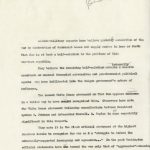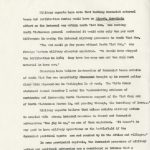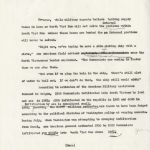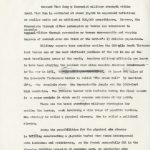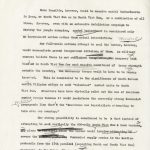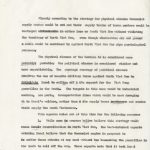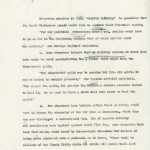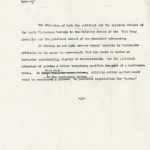1964, December 8, “Escalation of the War”
deepe
bomb–1
Dec 8
SAIGON–Military experts here believe probablye escalation of the war by destruction of Communist bases and supply routes in Laos or North Viet Nam is at best a half-solution to the problems of this war-torn public.
They believe the remaining half-solution entails internally a massive crackdown on unarmed Communist subversives and pro-Communist political agents who have infiltrated into the Saigon government’s sphere of influence.
The recent White House statement on Viet Nam appears to have in a veiled way to have caught recognized this. Observers here note the White House statement following consultations between President Lyndon B. Johnson and Ambassador Maxwell D. Taylor is expe especially significant in this report.
They note it is the first official statement at the highest American levels to recognize the war as “ a “struggle to defeat the externally-supported insurgency and agression …” In the past Washington official statements have the termed the war only that of “aggression”–meaning a de facto slow-motion invasion of into South Viet Nam from the North, rather than linking it with an insurgency–which is athe South Vietnamese in South Viet Nam rebelling against the constituted authority of the South Vietnamese Government. (More)
deepe
bomb–2
Military experts here not that bombing Communist external bases and infiltration routes would have no direct immediate effect on the internal war within South Viet Nam. And One ranking South Vietnamese general estimated it would make only ten per cent difference in easing the internal military pressures in South Viet Nam.
“The war could go for years without North Viet Nam,” one foreign Western military observer explained. “We should have stopped the infiltration in 1960; they have too many men and too mucy much material in here now.”
Observers here believe destruction of Communist bases outside of South Viet Nam was undoubtedly discussed brought up in recent policy disuc disu discussions in Washington la st week. The White House statement issued December 1 noted the “accumulating evidence of continuing and increasing North Vietnamese support of the Viet Cong and of North Vietnamese forces in, and passing through, the territory of Laos…”
Military experts believe that unless outside military action is coupled with strong internal measures to ferret out Communist subversives “the jig is up,” as one of them explained. “It doesn’t do any good to have military operations on the battlefield if the Communist political agents are not rounded up in the cities and villages.”
In some provincial capitals, the Communist pressures of military action and political subversion are s considered so intense that a current unlaughable joke in Saigon is. “The Communists control everything in provincial cities but the traffic.” The dilemn a is that to seize these (More)
deepe
bomb–2A
The dilemandilemma is that to seize systemicall systematically and justly those Communist subversives requires a strong stable Saigon government [that?] is now described as “an amiable, aimless anarchy.”
(More)
deepe
bomb–76
deepe
bomb–3
However, while military experts believe bombing supply bases in Laos or North Viet Nam will not solve the internal problems within South Viet Nam unless these bases are bombed the px internal problems will never be solved.
“Right now, we’re trying to save a skin sinking ship with a sieve,” one American field advisor explained. “The Communists stationed near the North Vietnamese border explained. “The Communists are coming in faster than we can stop them.
“But even if we plug the hole in the ship, there’s still alot of water to bail out. If we don’t do that, the ship still could sink.”
According to estimates of the American Military Assistance Command in Saigon, 5500 Communists infiltrated into South Vietnam by land and sea in 1961; 4200 infiltrated in the republic in 1962 and 4000 in 1964. Infiltration by sea is considered small. However, the MAC-V military estimates are known to have been fudged according to the political dictates of Washington policy at varying moments. During July, when Washington was attempting to downplay infiltration from Hanoi, one American general estimated 1800 to 2000 Communists infiltrated yer yearly into South Viet Nam since 1961.1960 yearly.
deepe
bomb–54
Current Viet Cong m Communist military strength within South Viet Nam is estimated at about 30,000 in organized battalions or smaller units and an additional 800,000 sympathizers. However, the Communists through either persuasion or terror are considered to exercise control either t hrough persuasion or terror unmeasurable and varying degrees of control over one third of the nation’s 15 million population.
Military experts here consider sealing the 900-mile South Vietnamese land border one of the most difficult problems of the war in one of the most troublesome areas of the world. American military officials are known to have been studying the problem ever since massive American involvementcommittment into the war in 1961, but is still yet subversived. At least 600300 miles of the Lao-South Vietnamese border is called “The Green Hell” by American GI’s, who complain about the impenetrable jungle and the 5000-foot high mountain. The 300600-mile border with Cambodia during the flood season is a soupy prairie in which small sampans can cross at any point.
There are two broad strategies military strategies for sealing the border, each involving a wide range of possible tactics. One strategy is called a physical closure. One is called a political closure.
Among the possibilities for the physical slo closure is building constructing a gigantic barbed wire fence interspersed with landmines and watchtowers, as the French successfully did in the Algerian campaing campaign at enormous cost, or scattering sism insoluble atomic wastes along the border to prevent human infiltration which Gen. Douglas Mc MacArthur suggested in the Korean War to stop Chinese invasions across the Yalu River.
deepe
bomb5–6
More feasible, however, would be massive aerial bombardments in Laos, or South Viet Nam or in North Viet Nam, or a combination of all three. However, even with an extensive defoliation campaign to destroy the jungle canopies, aerial bombardment is considered only an harrassment action rather than actual effective interdiction.
Any full-scale serious attempt to seal the border, howevertherefore, would necessitate ground troops–and divisions of them. As military sources believe there is not sufficient troop strength manpower basi based of in South Viet Nam for such massive commitment of troop strength outside the country, the necessary troops would have to be imporg imported. This is considered to be the significance of South Korean and Ph Filipino offers to send “volunteer” combat units to South Viet Nam. Observers here have virtually ruled out the use of American combat troops because it would re-inforce the currently strong Communist political propaganda line that ‘ “ the “Americans are imperialists attempting to take over our country.”
One strong possibility is considered to be k that instead of attempting to seal vertically the 900-mile South Viet Nam lb land borders, any plans to physicall close the borderwould [host or?] involve attempting to severe the Laostian panhandle Communist supply routes in the Laotian panhandle from the 17th parallel (separting North and South Viet Nam) westwards to the Mekong River and exithe Savannakhet, headquarters of right-wing Lao General Phoumi Nosavan. This possibility includes strong air attacks against Tec Tchepone and the two Pathet Lao regiments around it., which would be caught in the middle of the ground troops approaching in pincher movements from Beta east and west.
deepe
bomb–76
Clearly according to the strategy for physical closure Communist supply routes could be cut and their supply trains of human porters could be destroyed without att in either Laos or South Viet Nam without violating the territory of North Viet Nam, even though clandestine air and ground [say ?] a raids could be continued by against North Viet Nam for phys psychological purposes.
The physical closure of the borders ic is considered more probably; probable; the political closure is considered riskier and more unpredictable. The strategi strategy of political closure involves the use of massive military force against North Viet Nam to intimidate Hanoi to calling off t its support for the Viet Cong guerrillas in the South. The targets in this case would be industrial centers, sea ports, transportation lines which would be most damaging th to Hanoi‘s welfare, rather than t its supply bases in those and routes which supply the South Vietnamese.
This appears ruled out at this time for the following reasons:
1. While some in sourcr s belive believe this strategy would cause demolr demoralization in North Viet Nam, the best-informed experts watching Hanoi believe that the Communist regime is prepared to fn suffer these attacks at any cost without bee beseeching the guerrillas in the South to call off the war. These experts note that it took Hanoi three years to decide officially whether or not to support the guerrilla action in the South; the reason for the ong long delay is considered to be Hanoi was l in fact decidy deciding whether it would suffer the consequences of this support.
deepe
bomb–87
Observers consider it “ishi wishful thinking” to speculate that the North Vietnamese people would rise up against their Communist regime.
“For any political concessions from Hanoi, America would have to go so far in the flattening Hanoi that it would shatter world ope opinion,” one foreign diplomat explained.
2. Some observers believe that no military actions in South East Asia would be worth precipitating the x factor which might healclosure of the Sino-Soviet split.
“The Sino-Soviet split may be genuine but like all splits it can be healed by outside pressure,” one Western official explained. “The deeper the split, the greater the outisde p outside pressure needed to heal it. Do we want to force a South East Asia issue to heal the split?”
3. Few observers here believe either Hanoi or Peking would want to change the character of the war from an insurgency, which they are not winning,to a conventional war. But if massive military rel retaliation were applied against North Viet Nam, some observers here fear that Peking would react by Korean-style invasions but instead of being pince pinchered into a peninsula as in Korea, “There would be millions of the bloody little deils dei devils all across South East Asia to India .”
“American could s then win only by using the atomic bomb,” one American official explained. “But having won the war the world would take [50?] generations to re-build.”
deepe
bomb–98
The objective of both the political and the physical closure of the South Vietnamese borders is the eventual military defeat of the Viet Cong guerrilla and the political defeat of the Communist subversive.
If victory is not atta won–or deemed winnable by Washington officials in the years to come–North Viet Nam could be bombed or bombarded sporadically, lightly or intermittently for the political advantage of gaining a better bargaining position for atht at a conference table. In this the long range futurethis case, military action against Hanoi would be considered in the long-range future a prelude to political negotiations for “peace.”
-30-
Read Previous Article: 1964, November 24, “Overtures to Send 5,000 Filipino Troops”
Read Next Article: 1964, December 11, “First American Helicopters Arrived in Vietnam”

